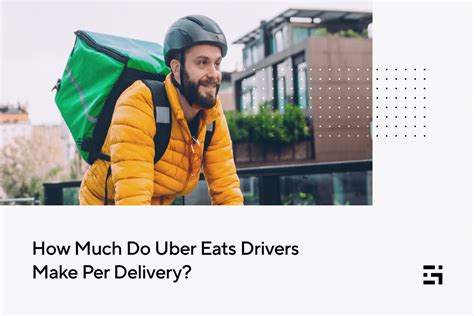How Much Do Uber Eats Drivers Make Per Delivery

Welcome to a comprehensive exploration of the income potential for Uber Eats drivers. This article aims to delve into the intricacies of earnings for these gig workers, providing an in-depth analysis of factors influencing their income. We will cover the average earnings per delivery, strategies to maximize profits, and insights into the broader economic implications of this gig economy role. Join us as we navigate the financial landscape of Uber Eats drivers and uncover the realities of their earning potential.
Unveiling the Earnings: Understanding the Uber Eats Driver Income

The earnings of Uber Eats drivers have been a subject of interest and curiosity, especially in the context of the gig economy’s rise. These drivers, often referred to as couriers or delivery partners, play a crucial role in the on-demand food delivery industry, connecting hungry customers with their favorite restaurants. But how much does this service truly compensate its drivers per delivery? Let’s delve into the specifics.
On average, Uber Eats drivers in the United States can expect to earn between $8 and $12 per delivery, depending on various factors. This range is influenced by the delivery distance, time of day, demand, and any applicable promotions or bonuses. For instance, deliveries during peak hours or in high-demand areas often attract higher earnings.
However, it's essential to note that this income is not solely dependent on the number of deliveries. Uber Eats drivers are independent contractors, meaning they have the flexibility to work whenever they choose. This allows for efficient route planning, which can significantly impact their overall earnings. By strategically selecting deliveries and optimizing their routes, drivers can maximize their profits, sometimes even exceeding the average hourly wage for traditional jobs.
Factors Influencing Earnings
Several key factors influence the earnings of Uber Eats drivers, and understanding these can help both potential and existing drivers make informed decisions about their work. Here’s a breakdown of some of the most significant influences on driver income:
- Delivery Distance: Longer delivery distances often result in higher earnings, as drivers are compensated for their time and mileage. This can vary based on the specific rates and structures set by Uber Eats for different regions.
- Time of Day: Deliveries during peak hours, typically evenings and weekends, tend to be more lucrative. Uber Eats often implements surge pricing during these periods, boosting earnings for drivers.
- Demand: Higher demand areas, especially those with a concentration of popular restaurants and busy commercial zones, offer more delivery opportunities. This can lead to increased earnings as drivers can complete more deliveries within a shorter timeframe.
- Promotions and Bonuses: Uber Eats frequently offers various promotions and bonuses to drivers. These can include incentives for completing a certain number of deliveries, referrals, or even specific challenges set by the platform. Such initiatives can significantly boost a driver's earnings.
- Efficiency and Route Planning: Experienced drivers understand the importance of efficient route planning. By optimizing their routes and selecting deliveries wisely, they can reduce idle time and maximize earnings per hour.
To illustrate the impact of these factors, consider the following table showcasing average earnings for Uber Eats drivers in different scenarios:
| Scenario | Average Earnings per Delivery |
|---|---|
| Short-Distance Deliveries (1-2 miles) | $8 - $10 |
| Long-Distance Deliveries (5+ miles) | $10 - $12 |
| Peak Hours (Evenings and Weekends) | $10 - $14 |
| High-Demand Areas | $12 - $16 |
| With Promotions and Bonuses | $12+ (can vary widely) |

These estimates provide a snapshot of the potential earnings, but it's important to remember that actual earnings can vary significantly based on individual performance, location, and other factors. Nevertheless, this data offers a useful framework for understanding the income potential of Uber Eats drivers.
Maximizing Earnings: Strategies for Uber Eats Drivers

To truly optimize their earnings, Uber Eats drivers must employ strategic approaches. Here, we’ll explore some key strategies that can help drivers make the most of their time and effort, ultimately boosting their income potential.
Understanding the Market and Demand
Gaining a deep understanding of the local market and demand dynamics is crucial for Uber Eats drivers. This knowledge enables them to identify the most lucrative delivery areas and times. For instance, residential neighborhoods might see higher demand during lunch hours, while downtown areas may thrive during the dinner rush. By recognizing these patterns, drivers can position themselves to take advantage of peak demand periods, thereby increasing their earnings.
Efficient Route Planning and Time Management
Efficient route planning is a cornerstone of success for Uber Eats drivers. By utilizing mapping tools and considering delivery locations, drivers can minimize travel time and maximize the number of deliveries they can complete in a given shift. This strategy not only boosts earnings per hour but also helps drivers maintain a positive customer experience by ensuring timely deliveries.
Additionally, effective time management plays a pivotal role. Drivers should aim to minimize idle time between deliveries. This might involve accepting back-to-back orders or strategically planning their routes to quickly return to high-demand areas. By doing so, drivers can maximize their active work time and increase their overall earnings.
Leveraging Promotions and Bonuses
Uber Eats often offers various promotions and bonuses to incentivize drivers. These can range from sign-up bonuses for new drivers to ongoing incentives for completing a certain number of deliveries or referring new drivers. By staying informed about these promotions and actively participating, drivers can significantly boost their earnings. It’s a simple yet effective strategy to maximize income.
Building a Reputation and Customer Base
In the gig economy, reputation is paramount. By consistently delivering excellent service, Uber Eats drivers can build a solid reputation, leading to higher customer ratings and, consequently, more delivery opportunities. This strategy not only increases earnings but also provides a sense of job security, as drivers with strong reputations are often preferred by the platform.
Furthermore, building a loyal customer base can offer additional benefits. Some customers might request the same driver for future deliveries, providing a steady stream of income. This personal connection can also lead to tips, which can significantly boost a driver's earnings.
Economic Impact and Implications
The role of Uber Eats drivers extends beyond individual earnings; it has broader economic implications. This section explores the impact of the gig economy on local businesses, customers, and the overall economy.
Benefits for Local Businesses and Customers
Uber Eats and similar platforms provide a valuable service to both local businesses and customers. For businesses, especially small restaurants, these platforms offer an affordable and efficient way to expand their reach and tap into a broader customer base. This can lead to increased sales and revenue, especially for those who might not have the resources to develop their own delivery infrastructure.
For customers, the convenience of on-demand food delivery is undeniable. It offers a simple solution for those with busy lifestyles or specific dietary needs. The platform's ability to provide real-time order tracking and estimated delivery times enhances the customer experience, fostering loyalty and repeat business.
Impact on the Gig Economy and Job Market
The rise of the gig economy, exemplified by Uber Eats, has had a profound impact on the job market. It has created a new category of jobs, offering flexibility and independence to workers. For many, especially those seeking part-time or temporary work, this has been a welcome development. It provides an opportunity to earn income on their own terms, fitting work around other commitments or personal preferences.
However, the gig economy also raises questions about worker rights and protections. As independent contractors, Uber Eats drivers do not receive the same benefits as traditional employees, such as health insurance, paid time off, or retirement plans. This lack of benefits has sparked debates about the responsibilities of platforms like Uber Eats and the need for regulatory interventions to ensure fair working conditions.
Conclusion: The Future of Uber Eats Drivers
The world of Uber Eats drivers is dynamic and ever-evolving. As the gig economy continues to grow, the role of these drivers will likely become even more prominent. The strategies and insights provided in this article offer a glimpse into the current state of earnings and the potential for growth. However, it’s essential to recognize that the future of Uber Eats drivers is intertwined with broader economic trends and regulatory developments.
As the gig economy matures, we can expect to see more nuanced discussions about worker rights and benefits. This might lead to innovative solutions, such as portable benefits or new forms of collective bargaining for gig workers. Additionally, technological advancements could further optimize the delivery process, enhancing efficiency and earnings for drivers.
In conclusion, the earnings of Uber Eats drivers are a fascinating reflection of the gig economy's potential and challenges. By understanding the factors influencing their income and implementing strategic approaches, drivers can maximize their earnings and contribute to the broader economic landscape. As we look to the future, the evolution of the gig economy and the role of Uber Eats drivers will undoubtedly be a topic of continued interest and discussion.
How much do Uber Eats drivers make on average per month?
+The average monthly earnings for Uber Eats drivers can vary significantly based on factors like location, time commitment, and efficiency. In general, drivers can expect to earn between 1,500 and 3,000 per month, with some high-performing drivers earning even more.
What are some tips for increasing earnings as an Uber Eats driver?
+To boost earnings, Uber Eats drivers can focus on efficient route planning, taking advantage of peak hours and high-demand areas, and participating in promotions and bonuses. Additionally, maintaining a high customer rating can lead to more delivery opportunities and potential tips.
Are there any additional costs or expenses for Uber Eats drivers?
+Yes, Uber Eats drivers are responsible for their own vehicle maintenance, fuel costs, and any potential fees associated with using the Uber Eats app. It’s important for drivers to factor these costs into their earnings to ensure a clear understanding of their net income.
What is the typical work schedule for Uber Eats drivers?
+Uber Eats drivers have the flexibility to choose their own work schedule. They can work full-time, part-time, or even just a few hours a week. The beauty of the gig economy is that drivers have the autonomy to decide when and how much they want to work.



